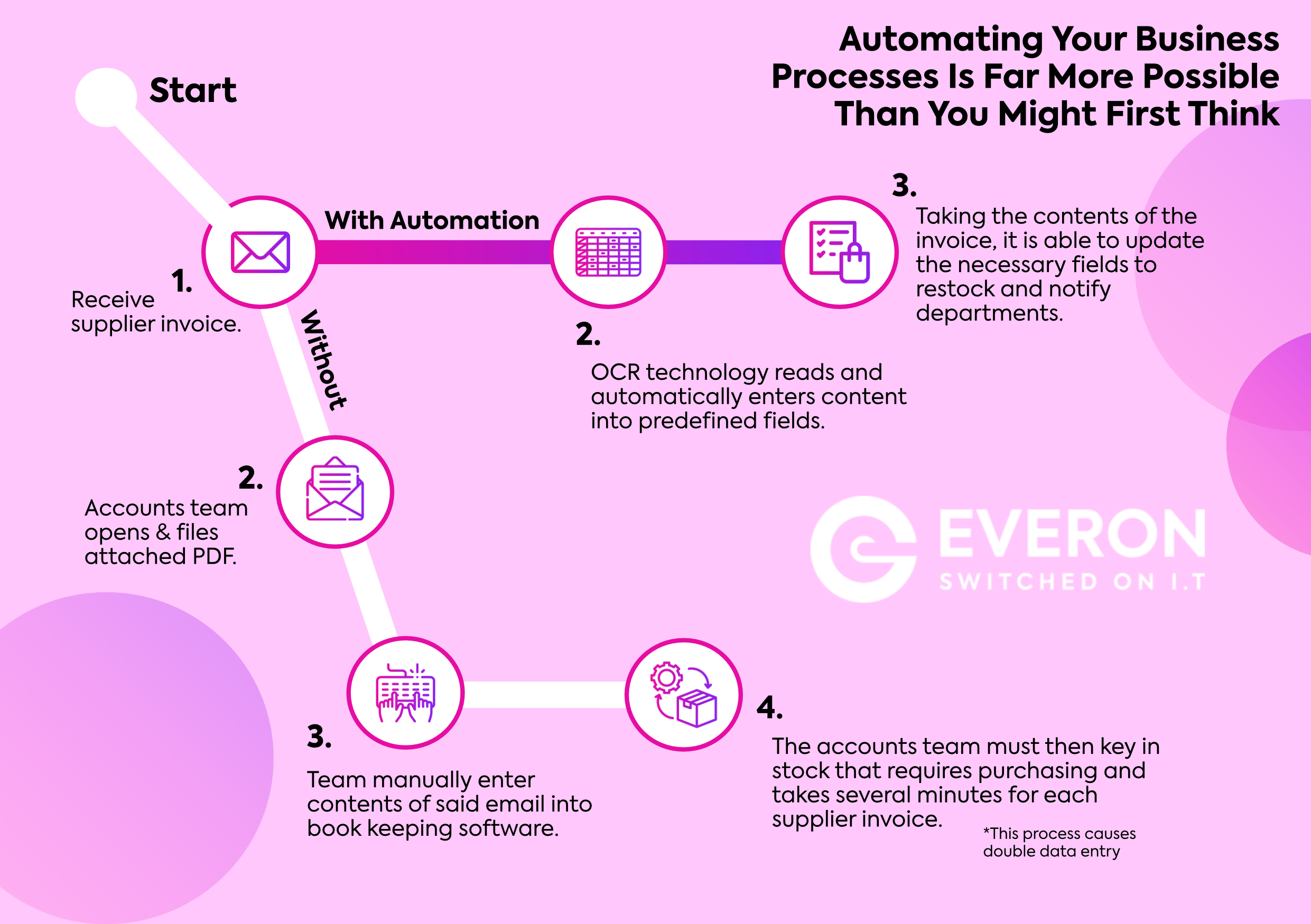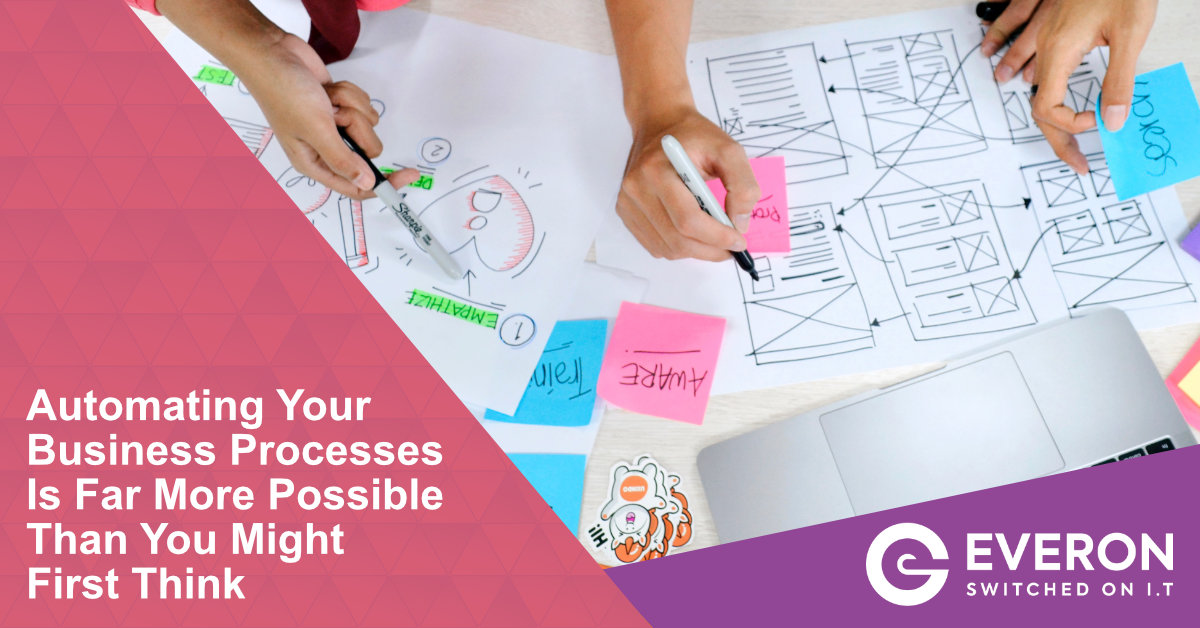What is automation?
When first thinking about automation, your mind might be drawn to a car factory – an image of robots building cars on a production line with minimal human involvement – or for those film buffs among you, your vision might be drawn to the far more sinister “robots building robots” of the Terminator movie series. This fear that automation and artificial intelligence has the potential to go far beyond its original intended purpose and start replacing humans, or like the films, much worse than that!
In your business environment and within the context of the automated processes we’re addressing within this article, automation = the computerization of repetitive admin processes. Tasks that follow a logical ordered series of actions each and every time.
Some tasks may well follow different paths depending on the parameters; following ‘if this, then that’ logic, Option A vs. Option B being selected within a list might trigger a different set of subsequent options depending on which one is selected, for example. Therefore, despite having varied routes the task may need to go, each of those routes will still be logical and structured in its order.
One of the areas where automated business processes deliver most value is in facilitating an automated ‘bridge’, (otherwise known as an API – or Application Programming Interface), between two otherwise independent software applications. Connecting them together to share data seamlessly back and forth, whereas without it, the only connection is through manual human intervention alone.
Take this example –
A supplier’s invoice is received by email into your office. Your accounts team open and file the PDF invoice attached to that email, while manually reading and entering the contents of that invoice into the book keeping software.
That invoice also serves as a delivery note and you need to update the stock and your purchasing & warehouse teams through alternative software that they use in their roles – within your ERP, (Enterprise Resource Planning), software. As your ERP platform is independent of your book keeping software, your accounts team must also key in data from that invoice into that platform too.
This process causes double data entry and takes several minutes to achieve for each supplier invoice.
If this process was automated –
As your invoices are received into a dedicated mailbox, a forward rule would push the contents into your book keeping software and leverages ‘OCR’ technology (object character recognition) to quite literally read the invoice and automatically enter that content into pre-defined fields (such as the date, invoice number, total, VAT, etc).
The automation would then be configured to trigger an action upon the creation of a new supplier invoice. Taking the contents of that invoice, and via the API link to your ERP software, updating the respective fields within that platform to update stock and notify the necessary departments.
What was a manual process of several minutes is now an automated action taken care of entirely by software, completed within a matter of a couple of seconds.
How is it relevant to my business?
Just think how many of those types of processes you have within the teams of your business and how much time is lost in manual admin tasks, which could otherwise be automated?
Not only are admin intensive repetitive tasks costing you an ever increasing sum of money to facilitate by human hand; they are by their very nature particularly mundane for the human’s involved – this risks a lapse in processes being followed, and creates a reasonable margin for error.
Automating such tasks and actions would save countless hours over a year in recouped time, claiming back thousands in salaries, which can be far better spent elsewhere. Human intervention time where human’s are best invested – in situations that require creative thought, strategy or personality. Automated systems replace humans only where the human effort is entirely wasted.
Get better value from your people, further protect your reputation, grow your service delivery and profitability – all as a result of technology helping you with the heavy lifting.
What processes can I automate?
The earlier example we gave within this article is just one of quite literally millions of possibilities. Think of anything that starts with a trigger – be it an action, (such as receiving an email or upon the creation of a new data record within a system), or a time-based reaction, (such as 9am on a Monday every fortnight), and then map-out the steps that follow.
If you can identify admin processes with one of those two triggers and then draw out a flowchart of the logical steps that follow, you too can automate your processes.
To help businesses on the journey to lightning the load caused by ‘red tape’, at Everon we provide a series of Time Saver Automation Packs – a single one-off fee to create a custom automation process using your existing systems and processes*.
Whether you are concerned about monitoring customer feedback and wish to be notified of a negative sentiment received within any email to your team, wish to automatically generate tasks in your project management system, or better pass notification alerts out to your team when other actions are taken elsewhere – we can setup and configure automations that will start saving you time and money today.
Need some help getting started?
If you are stuck on getting started with analysing and mapping out your processes – to spot opportunities for automation – or you have already identified admin intensive tasks that are prime for setting up within an automated process, Everon are here to help.
Engage our ongoing managed automation services & consulting via our monthly service, or get started with one of our pre-defined Time Saver Automation Packs.
*Integration possibilities may depend upon the type of existing software applications you use. Legacy systems or locally hosted systems do not typically have open API capabilities and will not integrate in the same way that cloud-based software applications can.


